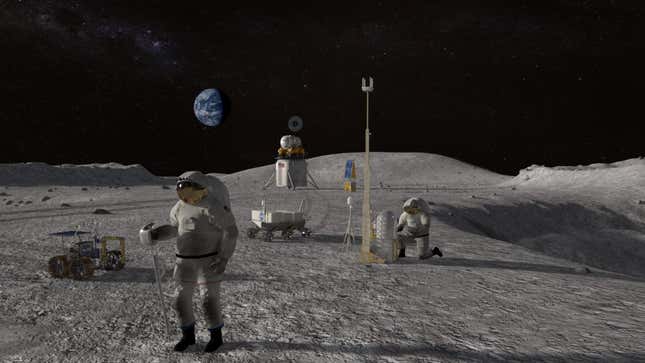
The Government Accountability Office said it’s becoming increasingly unlikely that a crewed lunar landing will be possible in just three and half years, citing technical risks and ongoing management issues at NASA.
These concerns were raised in GAO’s 50-page report, titled NASA Lunar Programs: Significant Work Remains, Underscoring Challenges to Achieving Moon Landing in 2024. The report said NASA has made some progress over the past couple of years, but a “fast-tracked schedule” and looming “technical risks” means it’s “less likely a lunar landing will happen in 2024.”
NASA was originally told to plan for a crewed landing in 2028. But in March 2019, the Trump administration pushed the Artemis 3 mission to 2024 (Artemis 1 will involve the inaugural launch of NASA’s Space Launch System or SLS, while Artemis 2 will involve a crewed mission to the Moon and back, but with no lunar landing). The Biden administration has expressed its support for Artemis 3, but no decision has been made about the 2024 timeline. The new report, which was released on May 26 by Congress’ nonpartisan watchdog, could have a serious impact on how the president would like things to move forward.
That said, NASA continues to work under the accelerated timeline, which is influencing the development of several lunar programs, including a robotic lunar rover, a human landing system (HLS), and Gateway, a space station that will operate in lunar orbit.
The new GAO report is the result of an appropriations request made by Congress in 2018. GAO officials analyzed mission documents, studied a 2020 NASA-sponsored study on the lunar program, and interviewed key NASA officials to evaluate progress and potential risks (analyses of SLS, the Orion crew capsule, and ground systems were excluded on account of them being reviewed last year). As GAO points out, NASA has made some progress since its last report in December 2019, citing contracts made for Gateway and HLS.
“However, the programs face several remaining challenges due to ongoing requirements changes, the use of immature technologies, and a pending mission decision on whether NASA will use the Gateway for the 2024 lunar landing,” GAO stated. “These challenges, along with the ambitious schedule, decrease the likelihood of NASA meeting the 2024 lunar landing goal.”
In terms of the technical risks, GAO raised concerns about the HLS, saying the planned pace is unrealistic. Development of this system needs to be “months faster” than other spaceflight programs due to the complexity required to support human spaceflight, according to the report. NASA recently awarded a contract to SpaceX to develop the HLS, but work has been suspended pending a review of the bidding process. GAO is also worried about the Gateway, saying the lunar outpost will have to “rely on power and propulsion technology that has never before been used, and contractor efforts to develop the technology are behind schedule.”
Specific management complaints include the absence of a firm cost estimate for the Artemis 3 landing and vague estimates and cost baselines related to work being done by private partners. What’s more, GAO said NASA hasn’t designated Artemis as a formal program, which prevents the space agency from following NASA’s program management policy. Accordingly, the report notes NASA “lacks a finalized roadmap for how it plans to manage the effort.”
“NASA assigned Artemis mission roles and responsibilities to specific divisions in response to a study finding; however, the agency has not clearly documented how it determined what key programmatic and technical tools it plans to use to guide mission decision-making,” the GAO report said. “Without doing so, NASA cannot ensure that it has the appropriate processes in place to track how the missions will achieve objectives and address risks at the mission level.”
“The GAO report released today should serve as a clear wake-up call both to NASA’s leadership and to Members of Congress that NASA’s Artemis Moon-Mars initiative is in serious trouble, and strong corrective actions will be needed if it is to succeed,“ Rep. Eddie Bernice Johnson, chairwoman of the House Committee on Science, Space, and Technology, said in a statement put out by Congress.
Johnson said the problems were not just budgetary in nature, but the result of “organizational weaknesses,” a reliance on unproven technologies, an “unrealistic timetable and acquisition approach,” among other complaints. The chairwoman has asked for an independent review of the entire Artemis undertaking, which will be required to put NASA onto an “executable path.” Failure to fix the problems, she said, would result in a “waste of money,” and result in a program that could place “astronauts and our nation’s standing” at risk.”
In its report, GAO made four key recommendations. The watchdog advised NASA to create a backup plan to accelerate the development of Gateway, re-think the station’s Power and Propulsion Element, and assess technical risks related to the system’s solar electric propulsion thrusters. GAO also recommended that NASA improve its policies relating to procurement and its technical management practices.
Interestingly, NASA was told to reduce the cost of its upcoming robotic lunar rover. Called VIPER, the lunar rover has an estimated price tag of $226.5 million. NASA agreed to all recommendations, save for the one pertaining to VIPER. But GAO insisted this “recommendation remains valid.”
Reading the report, it seems a no-brainer—at least to me—that NASA should be given a new timeline for the Artemis mission. It’s unclear if NASA can make the corrective actions given the current timetable. We’ve waited nearly 50 years for a crewed mission to the Moon, and we can wait a few years more if that’s what is needed to keep things safe.
More: Meet VIPER, NASA’s new water-hunting, crater-crushing lunar rover.